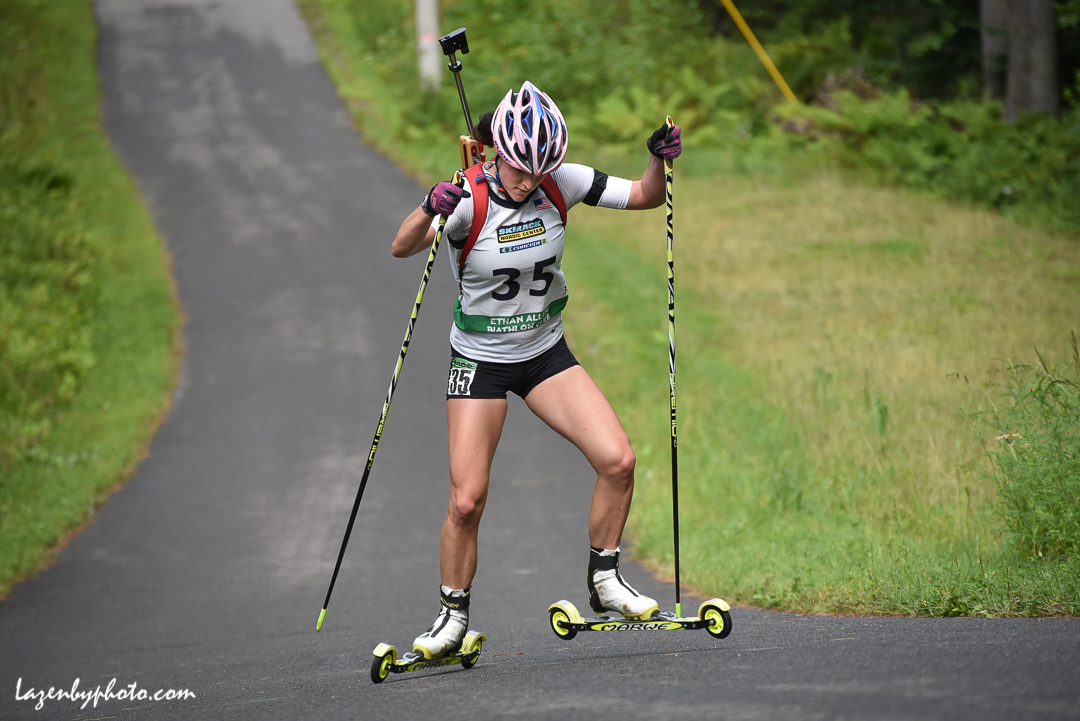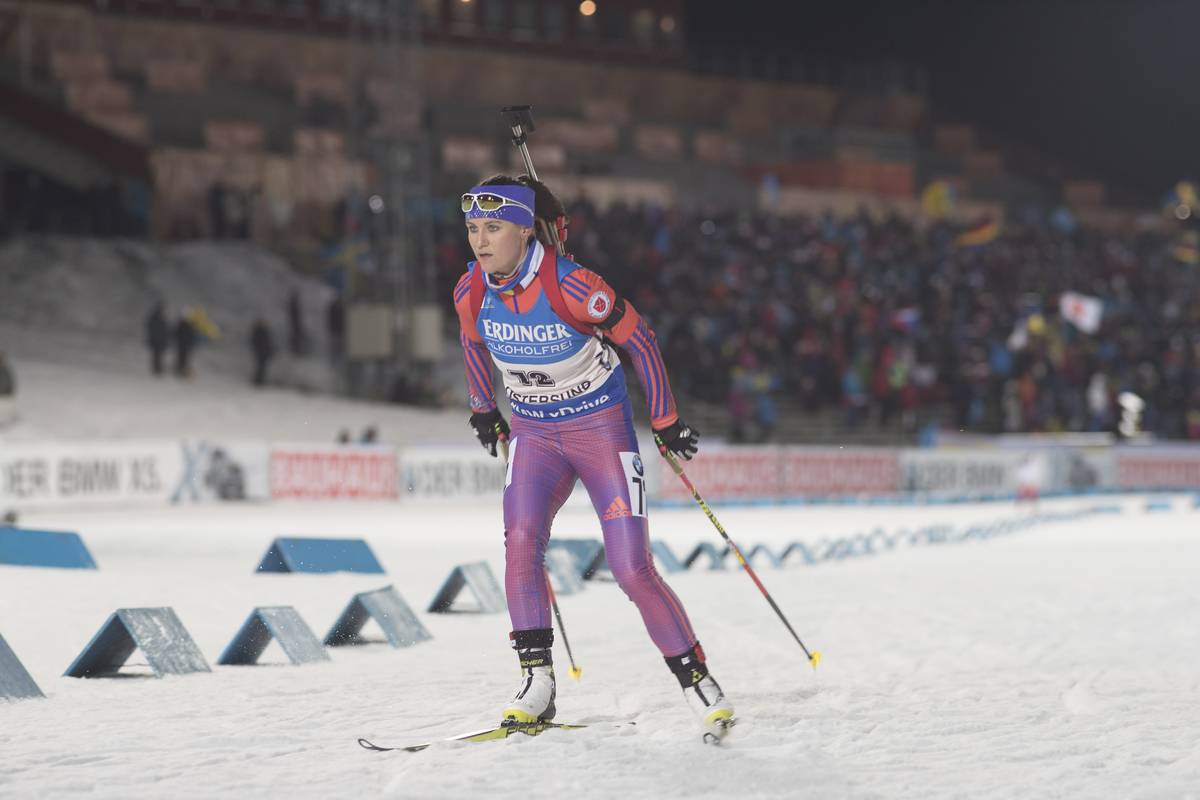
After making her debut in the World Cup points last season, Joanne Reid had a bumpier ride than expected on her way to being named to U.S. Biathlon’s Olympic Team.
Maybe twice as bumpy.
In March, a heart problem Reid had been dealing with came to the fore. “Hindsight is 20/20,” she said in an interview from Italy this week, guessing that she might have started having symptoms in 2014 or even earlier. But she had willed herself not to see a problem until a World Cup race in Kontiolahti, Finland, where she had a heart arrhythmia and nearly blacked out.
After meeting with a cardiologist and wearing a medical heart rate monitor, she was diagnosed as having paroxysmal supraventricular tachycardia, a type of arrhythmia which repeatedly caused her heartbeat to go into overdrive.
“One of them was specifically triggered by shooting,” Reid explained of the two tachycardias doctors eventually found. “It was caused by a high heart rate spike, like an interval or racing, and then the heart lowering. So every time I would try to shoot, especially in prone, I would get down on the mat and my heart rate would rise to bout 220, 230, sometimes as high as 275 beats per minute. Which, as you can imagine, is very, very difficult to shooting during.”
Reid’s type of supraventricular tachycardia is caused by the architecture of the heart, something she’s lived with since birth.
“Through the center of the heart is the AV node, which passes the signal from the top part of your heart to the bottom,” Reid explained. “In people with supraventricular tachycardia, for no particular reason you have two electrical pathways instead of just one. The current there can start current looping backwards, which will cause the signal to send twice. So your heart will start beating essentially twice as fast as it should. Because of that, it can’t fill all the way with blood and it isn’t effectively cycling blood [through the body].”
Some people born with these extra pathways never show symptoms; others get extra-high heart rates just from walking around. The onset of Reid’s symptoms as she entered the senior athlete pool is not unusual.

“What the cardiologist [at Massachussetts General Hospital] told me is that it’s most common for women ages 20-30 to have this,” she said. “It often goes away after 30 or 35. He didn’t know if it goes away because you stop being able to stress your heart to that level, and you can’t stress it enough to start looping, or something else. They have no idea.”
Although Reid now thinks that she had been having symptoms for several years, she did not identify them as such, through some combination of lack of knowledge and perhaps willful disbelief.
“I studiously ignored my problems until it was so blatant that I couldn’t ignore it anymore,” Reid admitted. “There were very clear indicators that something was wrong. I just kept ignoring them and I kept ignoring them, because I didn’t want to face the reality of that. It wasn’t until I was on the table, in my first procedure, and the doctor induced tachycardia and I saw it on the monitor and saw it happening and I could actually see my heart going through tachycardia, that I finally full believed that I actually had it.
“We all like to ignore our problems,” she continued. “I think I was mostly concerned that I had just imagined it in my head, that I was just imagining some excuse. That every time I had a bad performance, I could be like, oh, it was because of this problem and it’s not my fault. But it turns out that wasn’t the case.”
This type of heart arrhythmia is not life-threatening; others are. But even though it wasn’t necessarily dangerous, it was affecting Reid’s ability to train and compete.
“Episodes can last anywhere from 20 seconds, to I’ve had them run for more than an hour,” she said of the tachycardia. “It makes you feel really, really horrible. You’re body isn’t recovering correctly, your blood isn’t circulating correctly. You feel, not maybe full numbness, but you feel very heavy in your limbs because you’re not getting the blood flow that your body is expecting. So keeping functioning at a normal level is basically impossible.”

Reid has since gone back through the graphs of all of the data from her Polar heart rate data.
“When I went back and looked I had, you know, workout after workout – just hundreds of them – in my saved data, just staring me in the face,” she said. “And that’s all on me. I just believed, or I just wanted to believe, that this was Polar erroring, and it wasn’t… I wasn’t having just one bout of tachycardia and then I could continue with my workout. I was having a bout of tachycardia, and then a ten minute break, and then another bout of tachycardia, and then a ten minute break, and then another one.”
Eventually, in August, Reid had an ablation, a procedure which sends a catheter from the femoral artery up into the heart and then using radiofrequency to burn some of the tissue in the extra pathway.
If that sounds scary, it is. Reid actually had to do it twice.
“After the first round I didn’t have anything and I thought it was fixed – no tachycardia, no episodes, no anything until I was in Arber, Germany, with the ‘A’ team this summer,” Reid said. “It actually recurred and it recurred worse. It was probably the worst I had ever had. I contacted my cardiologist. He read my Polar heart rate graph and told me to fly directly back to Boston. They had me in for another ablation I think that same week.”
Based on the first experience, the night when she realized she would have to go through the ablation procedure again was one of the worst of the whole ordeal, Reid said.
“I remember calling my parents after the first one and telling them, if I had known how painful it would be I wouldn’t have done it,” Reid said. “So when I went in for the second round I was– that was killer.”
Another issue: that the two procedures came at the worst time imaginable for Reid’s hopes of racing the first period of World Cups. After each procedure, patients have to abstain from any high-heart-rate exercise for two weeks.

The first ablation was two and a half weeks before rollerski trials race in August. Those two competitions are scored along with two later in the autumn to determine who will be invited to a camp from which the World Cup team will be chosen.
The second procedure happened just before the second set of trials races.
“So that was basically it for my World Cup starts, and I knew that,” Reid said. “I kind of had to accept it at the time, that this was the price I was going to pay.”
Luckily, as her health and biathlon fortunes were shifting, Reid had some other things to think about, like finishing her engineering masters degree at CU Boulder in Information and Communication Technology for Development.
“There is definitely nothing more distracting than trying to defend your thesis, I will say that! That was right after the ‘A’ team went to the Canmore Camp, which is what decides the World Cup team. And that was great for me. It was a week in which I got to really take myself out of biathlon and worry about something else, do something else, and actually achieve something. I graduated. That was really, really awesome. And then back to the grind I went.”
Since the second ablation, she has been tachycardia free.
After going to selection races in Minnesota in December, Reid qualified for IBU Cup competitions which would serve as the final selection races for the Olympic team. There, she had a top finish of 20th in a sprint in Brezno, Slovakia, and made the cut for the U.S. team. She has since raced on the World Cup in Germany and Italy and is taking a break before joining a pre-Olympic training camp.
“That Olympic trials week isn’t easy for anyone. There are a lot of races and travel and a lot of stress. But we all had to do it, so in some sense it was fair. And it was pretty likely that I was going to end up at those races whether or not I raced the first period of World Cups, so I don’t have any complaints about that,” she said.
As for the Olympics, her first?
“Pretty excited! I think that’s going to sink in a little bit more later.”
Despite the bumps along the way, and the procedures burning her heart with a laser, she’ll be there.
“There was a lot of overwhelming relief that that gamble paid off,” Reid said. “There was a chance that it may not have… there is some risk involved. If the procedure gets messed up you end up with a pacemaker, and you’re not going to be an elite athlete if you have a pacemaker. And I had a lot of worries at the time that it would somehow affect the overall functionality of my heart. That turned out to I think be unfounded. But the procedure – they are in there and they are burning things out of your heart. It’s pretty scary.”
Chelsea Little
Chelsea Little is FasterSkier's Editor-At-Large. A former racer at Ford Sayre, Dartmouth College and the Craftsbury Green Racing Project, she is a PhD candidate in aquatic ecology in the @Altermatt_lab at Eawag, the Swiss Federal Institute of Aquatic Science and Technology in Zurich, Switzerland. You can follow her on twitter @ChelskiLittle.



